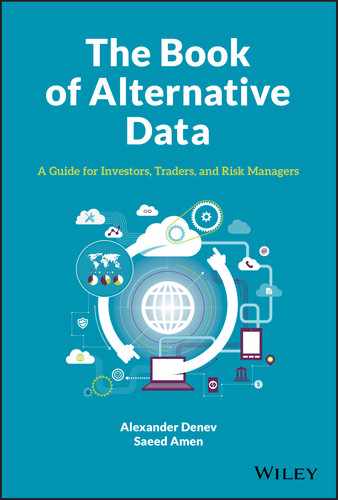Preface
Data permeates through our world, in ever increasing amounts. This fact alone is not sufficient for data to be useful. Indeed, data has no utility, if it is devoid of information, which could aide our understanding. Data needs to be insightful for it to be of use and it also needs to be processed in the appropriate way. In the pre-Big Data age days, statistics such as averages, standard deviation, correlations were calculated on structured datasets to illuminate our understanding of the world. Models were calibrated on (a small number of) input variables which were often well “understood” to obtain an output via well-trodden methods like, say, linear regression.
However, interpreting Big Data, and hence alternative data, comes with many challenges. Big Data is characterized by properties such as volume, velocity and variety and other Vs, which we will discuss in this book. It is impossible to calculate statistics, unless datasets are well structured and relevant features are extracted. When it comes to prediction, the input variables derived from Big Data are numerous and traditional statistical methods can be prone to overfitting. Moreover, nowadays calculating statistics or building models on this data must be done sometimes frequently and in a dynamic way to account for the always changing nature of the data in our high frequency world.
Thanks to technological and methodological advances, understanding Big Data and by extension alternative data, has become a tractable problem. Extracting features from messy enormous volumes of data is now possible thanks to the recent developments in artificial intelligence and machine learning. Cloud infrastructure allows elastic and powerful computation to manage such data flows and to train models both quickly and efficiently. Most of the programming languages in use today are open source and many such as Python have a large number of libraries in the sphere of machine learning and data science more broadly, making it easier to develop tech stacks to number crunch large datasets.
When we decided to write this book, we felt that there was a gap in the book market in this area. This gap seemed at odds with the ever growing importance of data, and in particular, alternative data. We live in a world, which is rich with data, where many datasets are accessible and available at a relatively low cost. Hence, we thought that it was worth writing a lengthy book to address how to address the challenges of how to use data profitably. We do admit though that the world of alternative data and its use cases is and will be subject to change in the near future. As a result, the path we paved with this book is also subject to change. Not least the label “alternative data” might become obsolete as it could soon turn mainstream. Alternative data may simply become “data”. What might seem to be great technological and methodological feats today to make alternative data usable, may soon become trivial exercises. New datasets from sources we could not even imagine could begin to appear, and quantum computing could revolutionise the way we look at data.
We decided to target this book at the investment community. Applications, of course, can be found elsewhere, and indeed everywhere. By staying within the financial domain, we could also have discussed areas such as credit decisions or insurance pricing, for example. We will not discuss these particular applications in this book, as we decided to focus on questions that an investor might face. Of course, we might consider adding these applications in future editions of the book.
At the time of writing, we are living in a world afflicted by COVID-19. It is a world, in which it is very important for decision makers to make the right judgement, and furthermore, these decisions must be done in a timely manner. Delays or poor decision making can have fatal consequences in the current environment. Having access to data streams that track the foot traffic of people can be crucial to curb the spread of the disease. Using satellite or aerial images could be helpful to identify mass gatherings and to disperse them for reasons of public safety. From an asset manager's point of view, creating nowcasts before official macroeconomic figures and company financial statements are released, results better investment decisions. It is no longer sufficient to wait several months to find out about the state of the economy. Investors want to have be able to estimate such points on a very high frequency basis. The recent advances in technology and artificial intelligence makes all this possible.
So, let us commence on our journey through alternative data. We hope you will enjoy this book!
